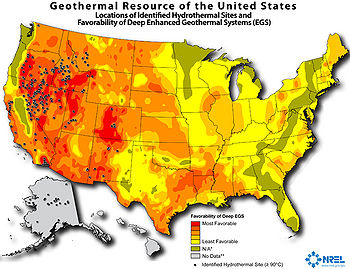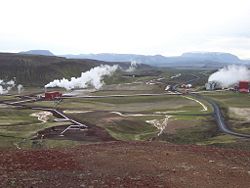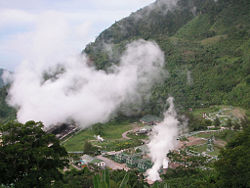Geothermal energy

In general terms, geothermal energy is thermal energy (the energy that determines the temperature of matter) generated and stored in the Earth. The geothermal energy of the Earth's crust originates from the original formation of the planet (20%) and from radioactive decay of minerals (80%). The geothermal gradient, which is the difference in temperature between the core of the planet and its surface, drives a continuous conduction of thermal energy in the form of heat from the core to the surface.
In terms of alternative energy, geothermal energy is the energy that is harnessed from the Earth's internal heat and used for practical purposes, such as heating buildings or generating electricity. The term geothermal power is used synonymously as the conversion of the Earth's internal heat into a useful form of energy, or more specifically as the generation of electricity from this thermal energy (geothermal electricity).
Geothermal power also refers to both the technology for converting geothermal energy into electricity and the electricity generated. Geothermal power is a characterization of the energy of heat from the earth (geothermal energy). Geothermal power also refers to both the technology for converting geothermal energy into electricity and the electricity generated.
- summarize the various methods that Geothermal energy/power is produced by tapping into the thermal energy created and stored within the earth.
Where hot springs, hot geysers, or steam vents bring forth heat from inside the earth, there, in places like Iceland, Hungary, Kenya, the Philippines, and the United States, geothermal power plants provide a constant, reliable, and renewable source of electricity.
pros and cons
- Geothermal provides a clear, sustainable, environmentally friendly and substantial resource. However, the science of geothermal energy generation is still young and developing economic viability.
However, it also faces challenges in that geothermal plants generally are site-specific and limited to regions with accessible deposits of high temperature ground water, the completing of a geothermal plant takes significant time (four to eight years) versus the times for wind or solar, and there is a lack of transmission lines (EIA 2011).
Geothermal comes from the Greek words geo, meaning earth, and therme, meaning heat. Prince Piero Ginori Conti tested the first geothermal power plant on July 4, 1904, at the Larderello dry steam field in Italy.[1]
| Renewable energy |
|---|
|
| Alternative energy |
Earth's geothermal resources
Geothermal energy is continually produced below the earth's crust, mostly as a result of decay of such radioactive materials as uranium and potassium (UCS 2009). It is considered sustainable energy because that thermal energy is constantly replenished and the extraction is small relative to total content (Ryback 2007); likewise, it is known as a renewable energy resource because of the vast amounts, similar to how light from the Sun is considered a renewable energy resource. Within about 10,000 meters (33,000 feet) of the Earth's surface there is considered to be about 50,000 times the amount of energy in all the world's oil and natural gas resources (UCS 2009).
.
Estimates of exploitable worldwide geothermal energy resources vary considerably. According to a 1999 study, it was thought that this might amount to between 65 and 138 GW of electrical generation capacity "using enhanced technology."[2]
A 2006 report by MIT that took into account the use of Enhanced Geothermal Systems (EGS) concluded that it would be affordable to generate 100 GWe (gigawatts of electricity) or more by 2050 in the United States alone, for a maximum investment of 1 billion US dollars in research and development over 15 years.[3]
The MIT report calculated the world's total EGS resources to be over 13,000 ZJ, of which over 200 ZJ would be extractable, with the potential to increase this to over 2,000 ZJ with technology improvements - sufficient to provide all the world's energy needs for several millennia.[3]
The key characteristic of an EGS is that it reaches at least 10 km down into hard rock. The MIT report estimated that there was enough energy in hard rocks 10 km below the United States to supply all the world's current needs for 30,000 years. At a typical site two holes would be bored and the deep rock between them fractured. Water would be pumped down one and steam would come up the other. There seems no reason why the steam should not feed an existing coal, oil or nuclear fired generating plant.
Drilling at this depth is now routine for the oil industry (Exxon announced an 11 km hole at the Chayvo field, Sakhalin. (Lloyds List 1/5/07, 6). The technological challenges are to drill wider bores and to break rock over larger volumes. Apart from the energy used to make the bores, the process releases no greenhouse gases. Compared to the difficulties of developing other forms of energy supply (nuclear, wind, wave, solar and so forth.) EGS seems to be well worth encouragement.
Although geothermal sites are capable of providing heat for many decades, eventually specific locations may cool down. It is likely that in these locations, the system was designed too large for the site, since there is only so much energy that can be stored and replenished in a given volume of earth. Some interpret this as meaning a specific geothermal location can undergo depletion, and question whether geothermal energy is truly renewable, but if left alone, these places will recover some of their lost heat, as the mantle has vast heat reserves. The government of Iceland states: It should be stressed that the geothermal resource is not strictly renewable in the same sense as the hydro resource. It estimates that Iceland's geothermal energy could provide 1700 MW for over 100 years, compared to the current production of 140 MW.[4]
The world's biggest geothermal energy resources are in China; the second-largest ones in Hungary. By taking account of its size (about the size area of Illinois), Hungary has the richest such resources per sq mile/km. The world's biggest producer of electricity from geothermal sources is the Philippines. Other important countries are Nicaragua, Iceland, New Zealand.
The largest dry steam field in the world is The Geysers, 72 miles (116 km) north of San Francisco. The Geysers began in 1960, has 1360 MW of installed capacity and produces over 750 MW net. Calpine Corporation now owns 19 of the 21 plants in The Geysers and is currently the United States' largest producer of renewable geothermal energy. The other two plants are owned jointly by the Northern California Power Agency and the City of Santa_Clara's municipal Electric Utility (now called Silicon Valley Power). Since the activities of one geothermal plant affects those nearby, the consolidation plant ownership at The Geysers has been beneficial because the plants operate cooperatively instead of in their own short-term interest. The Geysers is now recharged by injecting treated sewage effluent from the City of Santa Rosa and the Lake County sewage treatment plant. This sewage effluent used to be dumped into rivers and streams and is now piped to the geothermal field where it replenishes the steam produced for power generation.
Another major geothermal area is located in south central California, on the southeast side of the Salton Sea, near the cities of Niland and Calipatria, California. As of 2001, there were 15 geothermal plants producing electricity in the area. CalEnergy owns about half of them and the rest are owned by various companies. Combined the plants have a capacity of about 570 megawatts.
The Basin and Range geologic province in Nevada, southeastern Oregon, southwestern Idaho, Arizona and western Utah is now an area of rapid geothermal development. Several small power plants were built during the late 1980s during times of high power prices. Rising energy costs have spurred new development. Plants in Nevada at Steamboat near Reno, Brady/Desert Peak, Dixie Valley, Soda Lake, Stillwater and Beowawe, Nevada produce about 235 MW.
Geothermal power is very cost-effective in the Rift area of Africa. Kenya's KenGen has built two plants, Olkaria I (45 MW) and Olkaria II (65 MW), with a third private plant Olkaria III (48 MW) run by Ormat. Plans are to increase production capacity by another 576 MW by 2017, covering 25 percent of Kenya's electricity needs, and correspondingly reducing dependency on imported oil.
Geothermal power is generated in over 20 countries around the world including Iceland (producing over 26 percent of its electricity from geothermal sources in 2006), the United States, Italy, France, New Zealand, Mexico, Nicaragua, Costa Rica, Russia, the Philippines (production capacity of 1931 MW (2nd to US, 27 percent of electricity), Indonesia, the People's Republic of China and Japan. Canada's government (which officially notes some 30,000 earth-heat installations for providing space heating to Canadian residential and commercial buildings) reports a test geothermal-electrical site in the Meager Mountain–Pebble Creek area of British Columbia, where a 100 MW facility could be developed.
Capacity and Production
If heat recovered by ground source heat pumps is included, the non-electric generating capacity of geothermal energy is estimated at more than 100 GW (gigawatts of thermal power) and is used commercially in over 70 countries.[3]
Geothermal power provides 0.416 percent of the annual world energy consumption.[5]
During 2005, contracts were placed for an additional 0.5 GW of capacity in the United States, while there were also plants under construction in 11 other countries [6]
Geothermal energy/power is produced by tapping into the thermal energy created and stored within the earth.
Several entities, such as the National Renewable Energy Laboratory and Sandia National Laboratories, conduct research toward the goal of establishing a proven science around geothermal energy. The International Centre for Geothermal Research (IGC), a German geosciences research organization, is largely focused on geothermal energy development research.
Geothermal power can also be harnessed by pumping hot brine up from deep below the surface or by cycling surface water deep underground through regions of hot rock. In some places geothermal power would refer to the use of hot water directly such as for heating homes. Numerous sites for development as geothermal power sources remain unexploited. In 2005, new geothermal power plants were under construction in a dozen countries.
Power plants
Three different types of power plants—dry steam, flash, and binary—are used to generate power from geothermal energy, depending on temperature, depth, and quality of the water and steam in the area. In all cases the condensed steam and remaining geothermal fluid is injected back into the ground to pick up more heat.
Dry steam
A dry stream power plant uses hot steam, typically above 235°C (455°F), to directly power its turbines. This is the oldest type of power plant and is still in use today.
Flash steam
Flash steam power plants use hot water above 182°C (360°F) from geothermal reservoirs. As the water is pumped from the reservoir to the power plant, the drop in pressure causes the water to vaporize into steam to power the turbine. Any water not flashed into steam is injected back into the reservoir for reuse.
Binary-cycle
The water used in binary-cycle power plants is cooler than that of flash steam plants. The hot fluid from geothermal reservoirs is passed through a heat exchanger, which transfers heat to a separate pipe containing fluids with a much lower boiling point. These fluids, usually Iso-butane or Iso-pentane, are vaporized to power the turbine.[7]. The advantage to binary-cycle power plants is their lower cost and increased efficiency. These plants also do not emit any excess gas and are able to utilize lower temperature reservoirs, which are much more common. Most geothermal power plants planned for construction are binary-cycle.
Heat Pumps
Direct use
Enhanced geothermal systems
Water injection In some locations, the natural supply of water producing steam from the hot underground magma deposits has been exhausted and processed waste water is injected to replenish the supply. Most geothermal fields have more fluid recharge than heat, so re-injection can cool the resource, unless it is carefully managed.
Electricity
- Geothermal thermal energy is used to generate electricity typically via a well that is drilled into an underground reservoir of water that can be as hot as 371 degrees Celsius (700 Fahrenheit). At the surface, a turbine is turned using the trapped steam. Heat pumps are used to move fluids through pipelines buried underground at depths where the temperature does not change much and delivered to a home or commercial building. During the summer, this pipeline can pull heat out of a building and uses cooler fluid to cool the building. Geothermal water also is found in geysers or hot springs on the Earth's surface (EIA 2011).
- In the United States, geothermal is one of the renewable energy resources used to produce electricity, but its growth is slower than that of wind and solar energy development and a November 2011 report noted that it produced just 0.4% of the electricity from all sectors nationally during the first 8 months of that year, with 10,898 million kilowatthours (kWh) produced during that time. However, about 5% of the electricity generated in California was produced from geothermal, although there are significant geothermal resources that could be utilized (EIA 2011).
History
Benefits and challenges
Geothermal energy offers a number of advantages over traditional fossil fuel based sources. From an environmental standpoint, the energy harnessed is clean and safe for the surrounding environment.[8] It is also sustainable when managed with sensitivity to the site capacity because the hot water used in the geothermal process can be re injected into the ground to produce more steam. In addition, geothermal power plants are unaffected by changing weather conditions.[9] Geothermal power works continually, day and night providing baseload power. From an economic view, geothermal energy is extremely price competitive in some areas and reduces reliance on fossil fuels and their inherent price unpredictability. Given enough excess capacity, geothermal energy can also be sold to outside sources such as neighboring countries or private businesses that require energy. It also offers a degree of scalability: a large geothermal plant can power entire cities while smaller power plants can supply more remote sites such as rural villages.[10]
There are several environmental concerns behind geothermal energy. Construction of the power plants can adversely affect land stability in the surrounding region. For example, increased seismic activity can occur because of well drilling and land subsidence can become a problem as older wells begin to cool down. Dry steam and flash steam power plant also emit low levels of carbon dioxide, nitric oxide, and sulfur, although at roughly 5 percent of the levels emitted by fossil fuel power plants.
Notes
- ↑ Giancarlo Passaleva, President, and Raffaele Cataldi, Vice President, of UGI/Italian Geothermal Union "THE CELEBRATION OF THE CENTENARY OF THE GEOTHERMAL-ELECTRIC INDUSTRY WAS CONCLUDED IN FLORENCE ON DECEMBER 10, 2005" in IGA News 64 (April - June 2006), publication of UGI/Italian Geothermal Union. Retrieved July 24, 2007.
- ↑ Geothermal Energy Association - Washington, DC. Retrieved July 24, 2007.
- ↑ 3.0 3.1 3.2 The Future of Geothermal Energy, Idaho National Laboratory. Retrieved July 24, 2007.
- ↑ RESPONSE OF WAIRAKEI GEOTHERMAL RESERVOIR TO 40 YEARS OF PRODUCTION, 2006 (pdf) Allan Clotworthy, "Proceedings World Geothermal Congress 2000." Retrieved July 24, 2007.
- ↑ GLOBE Foundation of Canada "A Primer on Climate Change and Carbon Trading". Retrieved July 24, 2007.
- ↑ REN21 Global Status Report 2006"Renewables: Global Status Report". Retrieved July 24, 2007.
- ↑ Masashi Shibaki, "Geothermal Energy for Electric Power"REPP Issue Brief (December 2003). Retrieved July 24, 2007.
- ↑ Max Energy Limited is a thermal energy charity."Geothermal Energy". Retrieved July 24, 2007.
- ↑ BBC News "Kenya Looks Underground for Power". Retrieved July 24, 2007.
ReferencesISBN links support NWE through referral fees
- DiPippo, Ronald. 2005. Geothermal Power Plants: Principles, Applications and Case Studies. St. Louis, MO: Elsevier Science. ISBN 1856174743
- Ryback, L. 2007. Geothermal sustainability. GHC Bulletin 28(3): 2–6. Retrieved January 22, 2014.
- Savage, Lorraine. 2006. Geothermal Power (Fueling the Future). Farmington Hills, MI: Greenhaven Press. ISBN 0737735791
- Gupta, Harsh K. 2006. Geothermal Energy: An Alternative Resource for the 21st Century. St. Louis, MO: Elsevier Science. ISBN 044452875X
- United States Energy Information Administration (EIA). 2011. U.S. has large geothermal resources, but recent growth is slower than wind or solar. Energy Information Administration. Retrieved January 16, 2011.
- United States Energy Information Administration (EIA). 2013. Energy in Brief: How much of our electricity is generated from renewable energy?. EIA. Retrieved January 18, 2014.
External links
All links retrieved December 11, 2013.
- Energy Efficiency and Renewable Energy - Geothermal Technologies Program
- Enhanced Geothermal Resources
- Geothermal Education Office
- Geothermal Energy Association
- Geothermal Resources Council
- MIT - The Future of Geothermal Energy (14 MB PDF file)
- National Renewable Energy Laboratory - Geothermal Technologies Program
- Oregon Institute of Technology - Geo-Heat Center
- Southern Methodist University - Geothermal Lab
Credits
New World Encyclopedia writers and editors rewrote and completed the Wikipedia article in accordance with New World Encyclopedia standards. This article abides by terms of the Creative Commons CC-by-sa 3.0 License (CC-by-sa), which may be used and disseminated with proper attribution. Credit is due under the terms of this license that can reference both the New World Encyclopedia contributors and the selfless volunteer contributors of the Wikimedia Foundation. To cite this article click here for a list of acceptable citing formats.The history of earlier contributions by wikipedians is accessible to researchers here:
The history of this article since it was imported to New World Encyclopedia:
Note: Some restrictions may apply to use of individual images which are separately licensed.


